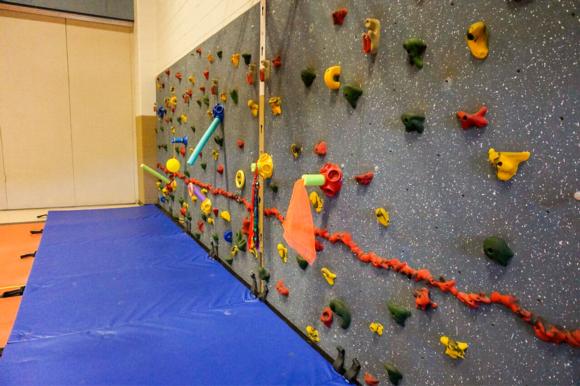Climbing Wall: Periwinkle Rescue
This is an excerpt from PE for Children with Moderate to Severe Disabilities by Michelle Grenier,Lauren J Lieberman.
Applicable Units
- Fitness
- Gymnastics
Age Group
Elementary school students. This can easily be adapted for middle and high school students.
Objectives
Students use balance, weight transferring, movement concepts, upper-body and lower-body strength, and endurance to traverse the climbing wall while stretching, bending, and twisting to remove objects from the wall and drop or throw them into buckets. Peers can also drop objects into the hula hoops or buckets.
National Standards Met
- Standard 1: The physically literate individual demonstrates competency in a variety of motor skills and movement patterns.
- Standard 2: The physically literate individual applies knowledge of concepts, principles, strategies and tactics related to movement and performance.
- Standard 3: The physically literate individual demonstrates the knowledge and skills to achieve and maintain a health-enhancing level of physical activity and fitness.
Grade-Level Outcomes
- S1.E7: Nonlocomotor (stability) - Balance
- S1.E8: Nonlocomotor (stability) - Weight transfer
- S1.E10: Nonlocomotor (stability) - Curling & stretching; twisting & bending
- S2.E1: Movement concepts - Space
- S2.E2: Movement concepts - Pathways, shapes, levels
- S3.E2: Engages in physical activity
Acceptable Outcome Variations
Students with disabilities reach, grasp, pull, and manipulate the sensory-engaging equipment that protrudes from the wall. They may use their vision to track, reach, or grasp, when choosing equipment on the wall. The paraeducator uses visual, verbal, and manual cues to engage these students.
Equipment
A variety of sensory-engaging objects that stick out from the wall, yarn balls, deck rings, hula hoops (see figure 14.3)

Climbing wall set up with a variety of sensory-engaging objects.
©Nancy Miller
Description
This activity can be done individually, in pairs, or as a group. Typically developing students start in a home space at the wall and traverse the wall, climbing on various pathways and levels to stretch, bend, reach, and grasp periwinkles (objects) on the wall to throw or drop into tidal pools (hoops or buckets). Students with disabilities, working independently or with a paraeducator or peer tutor, travel alongside the wall to stretch, bend, reach, and grasp sensory-engaging objects (periwinkles) on the wall and hold them, place them on lap trays, or drop them into tidal pools (hula hoops or buckets).
Directions
The description used for the activity is that at high tide all the periwinkles (objects on the wall) adhere to the rocks. The task for students is to traverse the wall and rescue (remove) the periwinkles and drop or throw them back into a tidal pool (hoop). Each student removes one periwinkle on each panel of the wall. At the end of the wall, each student travels back to the first panel and starts again. Once all the periwinkles are rescued, count the number of periwinkles in the hoops to determine a score. The game can be scored individually, in pairs, or as a team. Reset to play again. Student with disabilities collect larger sensory-engaging objects that they can either hold or drop into the hoops depending on their abilities.
Spatial Considerations
Each student starts at a wall panel and traverses from right to left staying on the panel until the peer in front has moved to the next panel.
Instructions for Peers
Support the student with a disability to the best of your ability. Recognize when the student is communicating a desire to play the game by looking at you or using sounds or gestures. Give the student visual and verbal cues to reach, grasp, and pull objects. Give positive specific and general feedback.
Instructions for Paraeducators
Recognize when the student is communicating a desire to play the game by looking at you or a peer or using sounds or gestures. Give the student verbal cues to reach, grasp, and pull objects. Facilitate interactions between student with disabilities and peers. Give positive specific and general feedback throughout the activity to students with disabilities and their peers.
Learn more about Physical Education for Children With Moderate to Severe Disabilities.
More Excerpts From PE for Children with Moderate to Severe DisabilitiesSHOP

Get the latest insights with regular newsletters, plus periodic product information and special insider offers.
JOIN NOW


